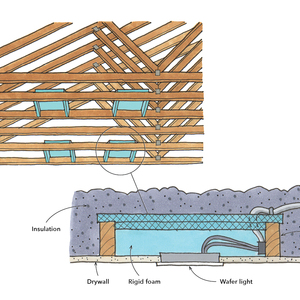Why is There Water in My HVAC Ducts?
The Energy Nerd supposes that condensation is the problem, and he offers a few possible solutions.
While remodeling a bathroom in my 1978 ranch house in northern Indiana, I nicked an insulated flex duct in the ceiling and water started pouring out. The ducts are connected to a heat pump that is primarily used for cooling, though it does supply some supplemental heating on either end of the heating season. All of the ductwork is in my unconditioned attic, and it’s mostly sitting on top of the blown-in cellulose insulation. Every fall, I close off the supply vents and put 2 in. of rigid foam in the returns. I plan on replacing the ducts, but I don’t want a repeat of the same situation. What’s causing this water problem, and how I can stop it?
—WILLIAM via email
Martin Holladay, editor of Green Building Advisor, responds: The most likely explanation for the water in your ducts is that warm interior air is entering the ducts during the winter, and the moisture in the air is condensing on the interior of the cold ductwork.
There are two possible ways to solve this problem. The first is to keep your ducts warm. Installing ducts in a vented unconditioned attic is always a bad idea. Ducts belong inside your home’s conditioned space. The best solution is to convert your vented unconditioned attic into an unvented conditioned attic; one way to accomplish this is to install closed-cell spray foam on the underside of your roof sheathing. This solution is effective but expensive.
A less-perfect solution is to leave your attic as is, but bury your ducts in insulation. Before you attempt this work, however, visit GreenBuildingAdvisor.com and enter “buried ducts” in the search box. Read up on the caveats before proceeding. Either of these solutions should keep your ducts warm enough to prevent condensation.
The second possible remedy to your condensation problem is to prevent indoor air from entering the ducts during the winter. Your attempt to plug the ducts with rigid foam was well-meaning but ineffective—almost certainly because your plugs weren’t airtight. Next time, use high-quality tape to get a good air-seal. Remember, you’re battling the stack effect, which is a powerful driving force. Air near your ceiling is eager to escape, so do a good job with the tape.
From Fine Homebuilding #283
Fine Homebuilding Recommended Products
Fine Homebuilding receives a commission for items purchased through links on this site, including Amazon Associates and other affiliate advertising programs.

Utility Knife

Foam Gun

Respirator Mask



























